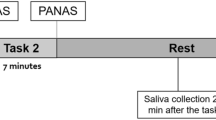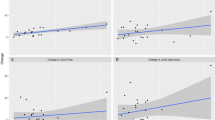Abstract
Psychosocial stress plays a major role in the etiology and the course of mental disorders that often show an altered activation of the hypothalamus–pituitary–adrenal (HPA) axis. The Trier Social Stress Test (TSST) reliably activates the HPA axis and reflects real life stress exposure. However, habituation may confound the results of clinical trials that apply TSST. The present study investigates the cortisol response after repeated psychosocial stress induction with short-term and long-term intervals between repeated testing sessions. Forty-one healthy subjects were exposed to the TSST four times with an interval of 24 h between the first and the second testing session (t1 and t2). The 3rd and the 4th testing session (t3 and t4) were also separated by a 24-hour interval whereas there were 10 weeks between t2 and t3. A significant decrease in the salivary cortisol responses was noticed from testing session t1 to t2 as well as from testing session t3 to t4. By contrast, there were no differences in the HPA axis reactivity between testing session t2 and t3. Our results demonstrated the habituation of the HPA axis to a standardized psychosocial stress test when testing was repeated after 24 h. By contrast, a renewed challenge with a ten-week-interval in-between activated the HPA axis in a similar manner as before. It is suggested that studies designed to investigate the HPA axis activity under repeated psychosocial stress conditions should apply the TSST three times in order to separate habituation from intervention effects.

Similar content being viewed by others
References
Armario, A., Vallès, A., Dal-Zotto, S., Márquez, C., & Belda, X. (2004). A single exposure to severe stressors causes long-term desensitisation of the physiological response to the homotypic stressor. Stress, 7, 157–172.
Bhatnagar, S., Huber, R., Nowak, N., & Trotter, P. (2002). Lesions of the posterior paraventricular thalamus block habituation of hypothalamic-pituitary-adrenal responses to repeated restraint. Journal of Neuroendocrinology, 14, 403–410.
Dickerson, S. S., & Kemeny, M. E. (2004). Acute stressors and cortisol responses: A theoretical integration and synthesis of laboratory research. Psychological Bulletin, 130, 355–391.
Dickerson, S. S., Mycek, P. J., & Zaldivar, F. (2008). Negative social evaluation—but not mere social presence—elicits cortisol responses to a laboratory stressor task. Health Psychology, 27, 116–121.
Dressendörfer, R. A., Kirschbaum, C., & Rohde, W. (1992). Synthesis of a cortisol-biotin conjugate and evaluation as a tracer in an immunoassay for salivary cortisol measurement. The Journal of Steroid Biochemistry and Molecular Biology, 43, 683–692.
Faul, F., Erdfelder, E., Lang, A.-G., & Buchner, A. (2007). G*Power 3: A flexible statistical power analysis program fort he social, behavioral, and biomedical sciences. Behavior Research Methods, 39, 175–191.
Gaab, J. (2011). Endokrine parameter als evaluationskriterien psychotherapeutischer Maßnahmen. Psychoendokrinologie und Psychoimmunologie, 1, 207–216.
Grissom, N., & Bhatnagar, S. (2009). Habituation to repeated stress: Get used to it. Neurobiology of Learning and Memory, 92, 215–224.
Kirschbaum, C., Pirke, K. M., & Hellhammer, D. H. (1993). The “Trier social stress test”—A tool for investigating psychobiological stress responses in a laboratory setting. Neuropsychobiology, 28, 76–81.
Kirschbaum, C., Pruessner, J. C., Stone, A. A., Federenko, I., Gaab, J., Lintz, D., et al. (1995). Persistent high cortisol responses to repeated psychological stress in a subpopulation of healthy men. Psychosomatic Medicine, 57, 468–474.
Kudielka, B. M., Hellhammer, D. H., & Kirschbaum, C. (2007). Ten years of research with the trier social stress test—revisited. In E. Harmon-Jones & P. Winkielman (Eds.), Social neuroscience: Integrating biological and psychological explanations of social behavior (pp. 56–83). New York, NY, US: Guilford Press.
Nesse, R. M., Bhatnagar, S., & Young, E. (2007). The evolutionary origins and functions of the stress response. In G. Fink (Ed.), The encyclopedia of stress (2nd ed.). New York: Academic Press.
Petrowski, K., Herold, U., Joraschky, P., Wittchen, H.-U., & Kirschbaum, C. (2010). A striking pattern of cortisol non-responsiveness to psychosocial stress in patients with panic disorder with concurrent normal cortisol awakening responses. Psychoneuroendocrinology, 35, 414–421.
Pitman, D., Ottenweller, J., & Natelson, B. (1990). Effect of stressor intensity on habituation and sensitization of glucocorticoid responses in rats. Behavioral Neuroscience, 104, 28–36.
Schommer, N. C., Hellhammer, D. H., & Kirschbaum, C. (2003). Dissociation between reactivity of the hypothalamus-pituitary-adrenal axis and the sympathetic-adrenal-medullary system to repeated psychosocial stress. Psychosomatic Medicine, 65, 450–460.
Simeon, D., Knutelska, M., Yehuda, R., Putnam, F., Schmeidler, J., & Smith, L. M. (2007). Hypothalamic-pituitary-adrenal axis function in dissociative disorders, post-traumatic stress disorder, and healthy volunteers. Biological Psychiatry, 61, 966–973.
Spitzer, R. L., Williams, J. B. W., Gibon, M., & First, M. (1990). SCID: User’s guide for the structured clinical interview for DSM-III-R. Washington DC: American Psychiatric Press.
Tafet, G. E., Feder, D. J., Abulafia, D. P., & Roffman, S. S. (2005). Regulation of hypothalamic-pituitary-adrenal activity in response to cognitive therapy in patients with generalized anxiety disorder. Cognitive, Affective, & Behavioral Neuroscience, 5, 37–40.
Wittchen, H. U., Zaudig, M., Schramm, E., Spengler, P., Mombour, W., Klug, J., et al. (1990). Strukturiertes klinisches interview für DSM-III-R. Weinheim: Beltz Test-Gesellschaft.
Wüst, S., Federenko, I. S., van Rossum, E. F. C., Koper, J. W., & Hellhammer, D. H. (2005). Habituation of cortisol responses to repeated psychosocial stress—further characterization and impact of genetic factors. Psychoneuroendocrinology, 30, 199–211.
Yehuda, R., Bierer, L. M., Sarapas, C., Makotkine, I., Andrew, R., & Seckl, J. R. (2009). Cortisol metabolic predictors of response to psychotherapy for symptoms of PTSD in survivors of the World Trade Center attacks on September 11, 2001. Psychoneuroendocrinology, 34, 1304–1313.
Young, E. A., Abelson, J. L., & Cameron, O. G. (2004). Effect of comorbid anxiety disorders in the hypothalamic-pituitary-adrenal axis response to a social stressor in major depression. Biological Psychiatry, 56, 113–120.
Young, E. A., Lopez, J. F., Murphy-Weinberg, V., Watson, S. J., & Akil, H. (2000). Hormonal evidence for altered responsiveness to social stress in major depression. Neuropsychopharmacology, 23, 411–418.
Acknowledgments
The authors’ sincere appreciation goes to Clemens Kirschbaum for analyzing the cortisol saliva probes and providing assistance with the TSST. The authors are most grateful to the Medical Faculty of the Technical University Dresden for supporting this study with a Young Researchers’ Grant (MedDrive).
Author information
Authors and Affiliations
Corresponding author
Rights and permissions
About this article
Cite this article
Petrowski, K., Wintermann, GB. & Siepmann, M. Cortisol Response to Repeated Psychosocial Stress. Appl Psychophysiol Biofeedback 37, 103–107 (2012). https://doi.org/10.1007/s10484-012-9183-4
Published:
Issue Date:
DOI: https://doi.org/10.1007/s10484-012-9183-4




